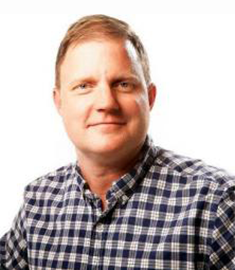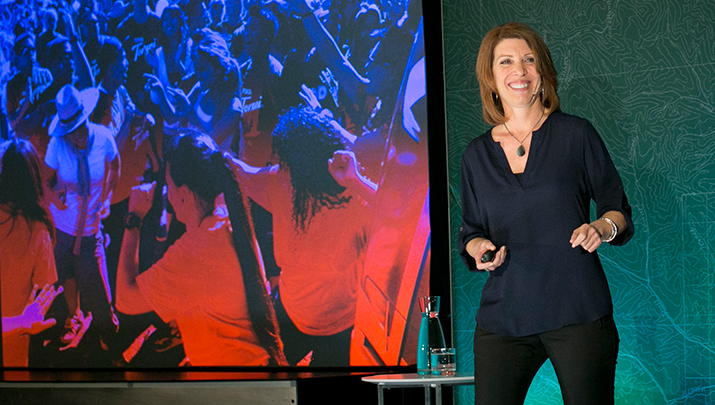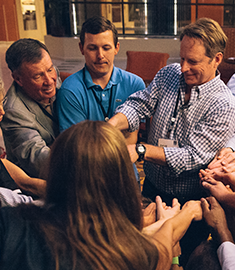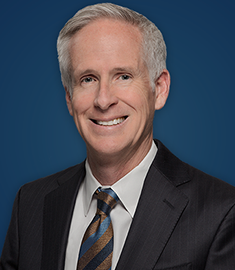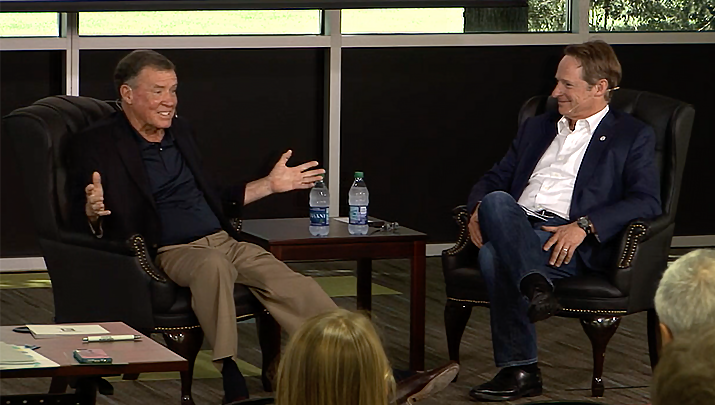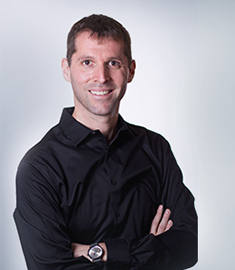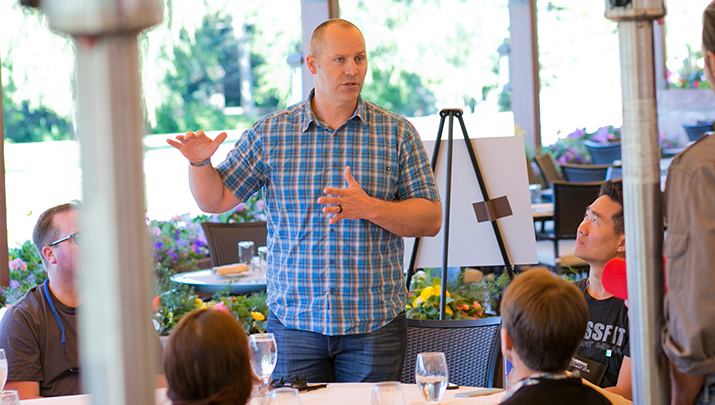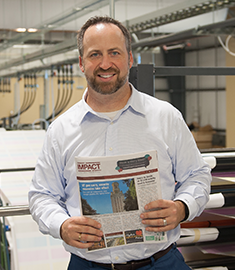The Relentless Pursuit of Better
I don’t remember a time when I didn’t want to be an airline pilot. So when I graduated from the University of Colorado in 1990 with a Bachelor of Arts in English and history and told my parents I wasn’t interested in going to law school as they’d hoped I would but rather that I wanted to go to flight school, they weren’t too pleased, but they also weren’t terribly surprised.
Three years later, after working as a flight instructor and freight pilot flying to Mexico and Central America, I had achieved my dream. I was hired as a first officer for the Delta regional airline Atlantic Southeast Airlines (ASA) in Atlanta. Since ASA was growing very rapidly at the time, the pathway to advancement was clear before me — upgrade to Captain in six to eight months, fly a few more years with ASA, then move on to a mainline carrier such as Delta or United. There was only one problem: the airline work environment.
Like the Hatfields and McCoys before us, no one could tell me who started the feud, but no two groups of workers in an airline environment got along. Mechanics hated ramp workers. Ramp workers hated flight attendants. Gate agents hated flight crews (of which I was a member). And we all hated airline management. Rest assured that safety was never an issue; we were all united in our commitment to safety and self-preservation, but that didn’t mean we couldn’t be nasty and condescending to one another while doing it. Therefore, after having invested six years of my life in pursing my dream career as an airline pilot, I just could not see myself enjoying the remainder of my work life in that environment. So I parked my plane at the Hartsfield airport in Atlanta, and I quit and became a broker of used corporate jets.
From 1996 to 2001, the corporate jet market was exploding, and it was a great time for those of us in the industry. While I do recall that my experience as a pilot was helpful to me in launching my own aircraft sales firm in 1997, it wasn’t until I started my current Evergreen business, TrafficSafetyStore.com, and began hiring larger numbers of employees that the lessons I gained working in the toxic airline environment began to really pay off.
Keep an open mind when hiring
By keeping an open — a very open — mind when it comes to hiring, I’ve managed to go 14 years with extremely low turnover. The only time we’ve had layoffs was after the 2008 recession, when we had to let two people go. We hire almost exclusively through word of mouth, which is a sign of our positive culture.
Also, we hire people who may be overlooked by other companies’ human resources departments. We’ve hired people who have been in jail, people who have had numerous DUIs and people whose wages have had to be garnished for child support. We even hired a man 14 years ago who, at the time, was living in his car and has become one of our most dependable employees.
Approximately 25 percent of our warehouse workers have something on their resumes that would disqualify them from a more traditional hiring plan. But I’ve found that if you see these folks as human beings, not just as resumes, and you set clear expectations for what it takes to thrive at your company, they’ll rise to the occasion.
Be flexible
In order to retain some of these employees, we’ve had to be flexible. While we don’t condone it, if someone has had a DUI and can’t drive, we’ll adjust their work shift for a few months to make sure they can get rides here. One man was missing a lot of work because he didn’t have child care, so we let him bring his son to work for a bit. We let one employee take a sabbatical for alcohol rehab. If you are a good employee, we’re going to work with you. It just makes sense as a human being. What good does it do to take someone who is down and dog pile on them?
Be explicitly clear about what you expect from people
I expect my employees to do a good job and be punctual, which is a sign of respect to their job. Their shifts start at 8 a.m. and end at 5 p.m. I don’t make them punch a card to prove when they got here; they just need to be here on time. If they’re not, we’re going to have a pretty serious conversation. I think people appreciate being treated as adults. After all, we’re equals. They expect a paycheck and health care from me. I expect them to do their job on time. We’re in it together.
Our employees are also incentivized by the fact that we almost always promote from within. That means they can see a goal to work towards instead of feeling like they are going to be stuck in the same job for decades.
Be transparent
We practice open-book reporting, which means every employee sees at least part of our finances and is responsible for making the company more efficient. We have a company-wide meeting every Friday morning, and the guys in the warehouse have a daily debriefing. Together we discuss whether we should channel profits into remodeling to make this a pleasant environment or into hiring consultants to talk to us about culture. This resonates with these guys. They tell me they appreciate the time and energy invested in them.
This also means you have to share bad news every now and then. While it hasn’t happened often, when we have had to terminate people, we immediately bring the whole company together to discuss what just happened. Obviously we don’t share personal information, but we want people to know what their former co-worker did, make it clear that that the person was treated fairly, but also that the company has standards that can’t be crossed.
Our journey together as a team
The motto on the back of our company T-shirt is a phrase that the guys in the warehouse themselves came up with: “The relentless pursuit of better.” We’re on a journey that we’re never going to finish — and every one of us can always do better. It’s so important to put this kind of faith into your employees, especially Evergreen employees who might be with you for decades.
Thanks in large part to the lessons I’ve shared here, TrafficSafetyStore.com has grown from one to 35 employees, and we now have three distribution centers nationwide. We saw 37 percent growth in 2015 and are right on target to finish 2016 with 25 percent growth. We’ll come in just under $15 million in annual revenue this year.
Do I miss flying for a living? Every day. But I must acknowledge that as a result of my decision to quit working as an airline pilot, I have built an Evergreen business that is providing a good living to more than 35 families, including my own. I’ve also been home for far more anniversaries, birthdays and parent-teacher conferences than I ever would have been had I stayed in the airline industry. Having said that, though, I still always look left and check out the cockpit whenever I board an airliner — old habits die hard.
Will Snook is the CEO of TrafficSafetyStore.com.
Jumping the Growth Curve - A Learning Journey
Who would have thought a scrappy little flavor company could transform itself into a 90-year-old startup? After leading Torani in achieving 25% growth per year for 15+ years, Melanie Dulbecco saw growth rates fall to low-single digits. She wondered if the maker of flavored syrups and sauces would ever be able to achieve startup-like growth again. Given poor economic conditions and amassing competition, low growth seemed a reasonable reset to expectations. Refusing to believe that, this self-professed strategy geek committed to a year-long “Learning Journey” with her management team, meeting with and learning from innovative companies about creating a culture for sustained growth.
In her Tugboat Summit 2016 talk, Dulbecco shares her insights and guiding principles for an effective Learning Journey and explains how this approach has shaped Torani’s culture of Pragmatic Innovation and Paced Growth.
Happy New Year From The Tugboat Team
Dear EJ Reader,
Happy New Year! We are delighted to join you in celebrating the end of one great year and the beginning of another at Tugboat Institute and the Evergreen Journal. Thank you for your passion, energy and dedication to our Evergreen community.
Reflections of the Past Year
Through the weekly distribution of the Evergreen Journal, we continued to chronicle important stories and ideas directly from our members. A heartfelt thank you to each of our EJ contributors for this tremendous gift you have given to our broader community.
In addition, we had a memorable 2016 with our Tugboat Institute Summit as well as our Fall Exemplar Visit at Jack Stack’s SRC in Springfield, MO. We’ve distributed talks from both events in the past few months and our library of talks will continue to grow through the new year.
We welcomed three new Tugboat team members: Dan Benetz as CFO, and Sean Zak and Jennifer Guo as Member Relations Managers for Tugboat Institute.
Lastly, we were honored to have a feature article about Tugboat Institute in Conscious Company Magazine in November. Meghan and Maren, the founders of the magazine, both joined us in Sun Valley last June and added to everyone’s experience.
Looking Ahead
From our perspective, 2017 is an important growth year for Tugboat Institute. The quality of our events, vitality of our community and health of Tugboat Institute are highly dependent on growing our community of value-aligned Evergreen leaders. We can’t overstate how important it is and how grateful we are to those who make valuable member candidate introductions.
New Innovations
Together, we’re continuing to co-create relevant and engaging innovations. We recently launched the Certified Evergreen™ program and encourage your management team and employees to participate. Certification gives your organization a publicly identifiable association with the highest business and operational standards that adhere to the Evergreen values.
Final Thoughts
All this is to say we have much to be proud of in our Evergreen community and Evergreen movement. Our efforts are destined to change the way society thinks about business. Evergreen entrepreneurs are building long-lasting, purpose-driven companies where success is something that is shared between owners and employees.
We look forward to a bright year ahead.
With Gratitude,
Dave & The Tugboat Team
Profiting from Millennials
There has been so much discussion about millennials, yet who do we really mean when we talk about millennials? Millennials include 32-year-old parents with college degrees and 10 years of work experience as well as high school seniors. Mark Zuckerberg and my high-school-age daughter Kelsey are both considered millennials, yet their interests and stages in life could not be more different. So how do we start to understand this group, which is poised to become a crucial demographic for all Evergreen entrepreneurs?
New Frameworks You Can Use
We started an in-depth demographics research project to become better advisors to our homebuilding-industry clients and quickly realized that we could help executives in all industries. Some 9,000 hours of research later, we published our findings in our new book: Big Shifts Ahead: Demographic Clarity for Businesses. In this article, we will highlight some of the millennial findings.
We decided to dig deeper and come up with better definitions for millennials and all generations. We analyzed the population by age, creating new generational definitions by decade born that dated all the way back to the 1930s. We gave each decade a name that represented one of the great demographic shifts they led, such as saving, work/family balance and the sharing economy. We found that businesses that identified these shifts prospered, while others failed.
We identified four major influencers of demographic shifts, noting that the same influence affected the generations differently based on their age at the time. These four big influencers (call them disruptors, if you like) are:
- Government policies
- Economic cycles
- Technological advances
- Shifts in societal acceptibility
The millennials born in the 1980s are different from those born in the 1990s and far different from their parents. While both the 1980s and 1990s generations number 44 million in size and comprise 3 million more people than those born in the 1970s, they spend very differently.
Older Millennials
1980s millennials, whom we dub the 1980s Sharers for their contributions to creating the sharing economy, have higher college graduation rates than any generation before them and graduated into the worst economy in more than 80 years. Compared with those born just 10 years earlier, they were 7 percent more likely to be living with their parents and 10 percent more likely to be single and childless at their 10-year high school reunion. Today, they have already formed 20 million of their 24 million households and are starting families and moving to the suburbs in increasing numbers.
Because of the economic disruption early in the Sharers’ adult lives, they borrow less and spend wisely. They will share your products and services with others if that makes financial sense. More than half (56 percent) of people under age of 35 said they would willingly share their location to get a discount coupon compared to 42 percent of those over 35. This group has no qualms about paying to jump into a stranger’s car or stay in a stranger’s house, partially because someone has shared that the stranger is safe.
Younger Millennials
1990s millennials, whom we dub the 1990s Connectors for the connections they keep on their smartphones, continue to graduate into a slowly growing economy. Jobs have been increasingly easy to attain for most, yet many remain underemployed because their skills and desires don’t match employers’ needs. Compared with the 1980s Sharers at the same age, 4 percent fewer drive, 3 percent more live with their parents, and another 3 percent more live with roommates. Observing what happened to the older millennials, they behave quite conservatively and take few risks.
Connectors watched their parents, and older millennials, go through the Great Recession. Many of them experienced real financial struggles as children and were the first generation to experience staycations instead of vacations. As a result, they spend cautiously, eschewing credit in favor of debit cards.
In a survey, 73 percent of Connectors agreed that as a society, we have given up on the concept of privacy. That means they are willing to share lots of information in return for convenience and discounts. That attitude gives companies a lot of room to collect valuable information on these potential customers.
Connectors use their phones for just about everything. They trust reviews by strangers and deplore salespeople because they would like to eliminate all middle men, instead purchasing what they need on their phones. Sell to them directly. Make it as easy as possible for them to buy on their phone. Make sure their friends tell them great things about your products and services. Connect with them.
A New Buyer
Most Evergreen CEOs have perfected selling to their peers, who tend to be 1950s Innovators, 1960s Equalers and 1970s Balancers. We understand them. Millennials — 1980s Sharers and 1990s Connectors — behave much differently. To improve our sales and marketing to these young adults as well as all of our customers:
- Change the internal marketing conversation from broad identifiers such as “millennials” to more specific categories, such as the decade in which they were born.
- Enhance the decade-born discussion to include life stage (single, married with kids, etc.), gathering as much data as possible about them.
- Recall how the four big influencers (government policy, economic cycles, new technologies and societal shifts) affected each group, especially in their teen years.
By segmenting the generations this way, I believe companies can have far more productive sales and marketing meetings, targeting their customers more effectively and thus growing profits. It is clear to me that the millennials born in the 1980s and 1990s will be the driving force of the economy for years to come, and Evergreen companies need profits from the millennials to accomplish their Purpose.
John Burns is the CEO of John Burns Real Estate Consulting.
Q&A With Jack Stack and Dave Whorton
For Evergreen entrepreneurs, few figures are as inspirational as Jack Stack, who has lived the 7Ps for decades. In this intimate, wide-ranging Q&A, which took place at this fall’s Tugboat Institute @SRC event in Springfield, Missouri, Stack shares stories from his youth and the thrilling first years of entrepreneurship, as well as his philosophies on management and parenthood. We hope you enjoy this candid talk with a true Evergreen icon.
Why Cash Isn’t Always The Best Motivator
Cash is the ultimate carrot, right?
Not necessarily. Especially for Evergreen entrepreneurs. We are building businesses based on passion, principal and Purpose. We want our employees to be part of our mission, and although people might believe money is important, it’s not the ultimate motivator.
We have given a lot of thought to bonuses at Acceleration Partners, my 9-year-old marketing firm, and are moving to a system that focuses more on experiences and meeting employee needs in a more personalized way.
For truly special bonuses, we’ve started something exciting at AP. We’re rolling out our own version of a “Dream Program,” where we subtly collect ideas—dreams, wants or preferences—from employees in interviews or casual conversations. Then, when the moment is right for a bonus, we turn to that catalogue for inspiration.
Just recently, we sent someone on a trip to Napa—plane tickets and a paid-for hotel—because she had always wanted to visit wine country. Another colleague wanted to take his kids to London, so we are flying them out before a conference this fall when they will have extra time to sightsee.
Buying tickets for a travel experience or giving an employee an opportunity they never would have had otherwise is not that expensive—often less than what a bonus check is expected to be. But a free vacation is a wallop of a gift. Employees are touched that we noticed their interests and that we helped create a long-lasting memory connected to the business. It creates loyalty.
On a smaller scale, about a year ago, we launched a program called TINYpulse to get a better read on our employees. TINYpulse is an employee engagement software platform that offers surveys, peer recognition and performance reviews. We use TINYpulse every week to ask people questions and to send cheers. I send personal thank you notes to employees when I notice they’ve been doing a great job. This kind of weekly recognition is supremely motivating to employees, and many have told them my comments made their day. People can handle stress and hard work if they feel supported. If they are just getting cash bonuses as a reward and no emotional support, the job starts to become transactional.
Cash, whether in the form of a bonus or salary, is not actually a great stimulus for great work, with the exception of a few functions such as sales. Several years ago, I read an exciting book: Drive: The Surprising Truth About What Motivates Us by Daniel H. Pink. It explores intrinsic motivators vs. extrinsic and why people do things. If people are motivated entirely by money, there is always someone out there who is willing to pay them more.
Evergreen companies need high-quality people who are invested in their work, and they need to avoid turnover. At Acceleration Partners, we focus on paying people in the 80th+ percentile while also working hard to recognize them as individuals. This provides an environment that makes them want to get up and go to work. And when someone comes to them with a better offer, it makes them think twice about what they value and would be giving up.
And we now surprise them with our new bonus program. We don’t want anyone changing jobs just so they can make $5,000 more somewhere else.
As a result, our turnover rate for top performers is very low. They are deeply invested in our company, and I don’t believe anyone has ever left with money as the primary motivator.
Rather than hand my employees a bonus check, I’d much rather hand them tickets to Hawaii and an experience they will never forget that is more personal.
Robert Glazer is the Founder & CEO of Acceleration Partners.
Chasing After Joy and Eating It Up
Robyn Sue Fisher’s story is one of Pragmatic Innovation and good old-fashioned invention. For Fisher, founder and Chief Brrrrista of Smitten Ice Cream, ice cream is all about experiencing joy in the present moment. It’s also all about serving customers a superior product free of unnecessary additives. A self-described “super nerd,” she set out to make fresh-to-order ice cream with only natural ingredients. With the help of a brilliant engineer, liquid nitrogen, her life savings and tremendous Perseverance, she invented a machine that made her vision possible and rolled out her first “store” on the back of a Radio Flyer wagon.
In her Tugboat Institute Summit 2016 talk, Fisher breaks down what matters most in building her Evergreen business: creating joy for employees and customers, and committing unwaveringly to being the best.
Great Customer Service On A Shoestring Budget
In my earlier years, I thought I was going to be a lawyer. I sure didn't plan to be a customer service strategist. But through serendipity and a strong interest kindled by early front-line jobs, I've had the good fortune to work in one aspect of this field or another since the late 1980s. As entrepreneur/partner, then owner/CEO of International Customer Management Institute (ICMI), and now as a writer and speaker, it’s been fun to watch customer service evolve into what it is today: a powerful brand differentiator.
I’ve enjoyed meeting and talking with Tugboat Institute members these past few years — if you’ve been to a Tugboat Institute Summit, we may have crossed paths a time or two. One thing Evergreen CEOs have in common, beyond their commitment to the 7Ps: Most don’t have significant investor money to throw at customer service (a good thing because, as with other aspects of building a strong business, that’s not often the best approach). Yet, service is exactly where the 7Ps really play out.
Good customer service is essential for any business to thrive. It doesn't matter how big your company is, who your competitors are or how entrenched they may be. If you have a product the market wants and you deliver on customer care, you win. All else being equal, if you demonstrate genuine regard for a customer’s service experience and your competitor doesn’t, you’re likely to earn loyalty and continued business. Conversely, if you drop the ball — if service isn’t easy, or if you let a customer’s complaint slip through the cracks unaddressed — that customer is likely to look for greener pastures (and will probably tell others about the experience).
So, how can an Evergreen business create a successful customer service approach without breaking the bank? Through all of the change I’ve observed over several decades, here are some recommendations that have staying power:
Be True To Your Brand
Most Evergreen CEOs take pains to imbue their products and marketing with a distinct personality. But they may not extend that to their customer service channels — and that’s a huge missed opportunity. You don’t want to pack your product full of character and greet your customers with a canned response. "Thank you for calling XYZ Company. Press 1 to speak to a representative" is not delightful. Take the time to make all of your messaging, across every channel and customer touch point, true to your voice.
Set The Right Foundation Before You Get Big
If you’re still a small company, now’s the time to get your processes in place — before you get so large that customer concerns become overwhelming. To get started on a plan that can scale as you grow, there are a few things to consider:
- How, when and where will you interact with customers? Identify a sensible mix of channels: web, mobile, social, phone, email, etc. Then determine who “owns” the overall approach that includes those channels. (The industry term is to shape a “customer access strategy.”) Many smaller companies can’t afford the luxury of a dedicated customer service team, so employees often pull double duty — and ownership and accountability are essential. By cultivating the right channels for the right purpose, you can create substantial efficiencies. Some new entrants are making a big difference. Social media can be an effective and affordable way to engage with customers, for example, and more companies are harnessing mobile tools such as text to great effect.
- What are your customer service standards? I have a mantra: No unnecessary heroics, please. We've all heard stories of companies going to extraordinary lengths for customers — hopping on a plane to hand-deliver a product that didn’t ship on schedule, for example. Impressive, sure, but heroics mean that you’ve dropped the ball somewhere earlier in the process. Ideally, you’ll never have to go to such extremes, but you do need to establish parameters for service. What does it mean to deliver quality? How far do you go with empowerment? What are you willing to do and how far are you willing to go for customers? Make sure everyone in your organization knows the answers to these questions and can deliver for the customer.
Bake Post-Mortem Reviews Into Your Process
Assessing your customer service activity should be as regular as reviewing your P&L. Taking note of and learning from these interactions creates a feedback loop that, in time, will minimize the need for customer service interactions.
One of the innovations Uber brought to taxi service is the ability for customers to provide immediate feedback. Today, you can survey customers through the channels that make the most sense: personalized email, text-based, dial-pad input following a call, and others. In an era when customers are fatigued from being over-surveyed, it’s notable how high the response rates can be for transaction-specific surveys that are short and easy.
Internally, track customer engagements by type. What are they? Billing problems? Technical support? Orders not arriving as expected? Difficulty understanding products or services? A well-oiled customer service approach can help improve virtually every aspect of your business by pinpointing operational and manufacturing hiccups, informing your marketing team about what customers need and want, and providing fodder for Pragmatic Innovation.
Set An Example By Engaging With Customers Yourself
Most Evergreen CEOs are great about this by virtue of living their Purpose and putting People First. John Bogle, founder of The Vanguard Group, was known for regularly carving out time to spend on the phone with customers in the call center. By doing this, he not only better understood customer needs, but he also saw firsthand the areas of service that needed attention. Above all, he sent a clear message to the rest of the team: Customer service matters.
The most successful companies view customer service as an opportunity, not an obligation. As you nail this aspect of your business, you’ll reap rewards in all the others.
Brad Cleveland is the Principal of Brad Cleveland Co. LLC.
Finding Your Team’s Harmonic Gait
Navy Seal Commander Rorke Denver refers to himself as a “sheepdog.” While serving in Iraq, he discovered he had a particular talent for taking care of, and protecting, others. He was there for his men during dozens of missions and he rose through the ranks to become a decorated leader, eventually recruiting and training cadets. Denver learned to value things like character, resilience and empathy over test scores and varsity letters. Like any good Evergreen leader, he realized that the qualities of his team were more important than their qualifications.
How Saving Newspapers Made Me Evergreen
When I tell a new acquaintance that I'm in the print news business, I can predict the response: Their brow furrows. Their voice lowers. They offer their condolences: “Oh, I’m sorry.”
But me? I’m all smiles. Because I run a newspaper company that’s profitable and growing.
I cut my teeth in the industry on the advertising side, beginning with the Houston Chronicle in the glorious 1990s. Business was good, and I got a solid education in all aspects of the print media world.
Eventually my wife and I returned to our hometown of Pflugerville, Texas, and I went to work at the nearby Austin Business Journal. I noticed that information about local construction projects was scarce to none. The things that affected neighbors’ day-to-day lives — like when a road would be built, what kind of businesses would be allowed and whether there would be a Starbucks — weren’t being covered by the local media. These issues were newsworthy to our little enclave, but not, apparently, to reporters.
I had an idea: What if we built a business journal for the Average Joe? One that treated the opening of a new Mom-and-Pop pizza joint like it was news? Because on a neighborhood level, it is.
My wife agreed to support my burgeoning entrepreneurism. I sketched my thoughts out on a piece of paper, drew up a business plan and, armed with a $40,000 personal line of credit, set up shop in the game room of our house. A small group of writers and designers and I worked our butts off to crank out that first edition in September 2005. Then, we held our breath.
Back then, I couldn't even afford voice mail — I just had a caller ID box (remember those?). After the first issue was delivered, I saw that 10 businesses had called to inquire about advertising with us. Our next edition's ad space was sold out in two weeks. We’d found a formula that worked, and it still works today.
In our first five years, we grew like crazy, adding 10 papers and about 60 employees. As of October, we have launched our 23rd paper. We reach more than 1.7 million households around the state and have 185 employees. We expect to pull in $25 million in revenue this year.
Our business works because we have a strong central Purpose: to build communities of informed citizens and thriving businesses through the collaboration of a passionate team. We provide quality reporting without editorializing. We cover elections, but we don't endorse candidates. Readers appreciate that we care about what’s happening in their backyards. Local business owners appreciate our coverage. Advertisers appreciate having their messages delivered to their most likely customers.
Although my business may differ from other Evergreen entrepreneurs’ because of the publishing industry’s unique concerns, I’ve learned some lessons in the last decade that I think are broadly applicable:
A Little Dead Means A Little Alive
I firmly reject the notion that print is dead; my company is proof that it’s alive and well. While Community Impact Newspaper was growing by $5 million to $6 million in revenue a year, the traditional newspaper industry was well into its downward spiral. Digital ad sales couldn’t keep up with operational costs, so papers cut jobs. When they cut jobs, content suffered. And when content suffers, readership suffers. And without readers, you can’t sell ads. These papers continue to fold at a disheartening rate.
But that doesn’t mean you can’t come up with a better model. We don’t have a huge digital presence, but that gives us the freedom to not care about clicks. So we go to the city council meetings that traditional local media now ignores because they don't generate clicks online. We sometimes cover stories that only a small number of households care about. In the micro-niches we cover, print wins.
We’ve embraced Pragmatic Innovation to reach a highly engaged audience where they live: through their mailboxes. Using a fine-tuned targeting system developed in-house, we can deliver news — and serve ads — down to the carrier-route level.
Pay Now Instead Of Later
A trusted mentor once advised me to get libel protection. I took a chance and went without — and sure enough ended up getting burned. Insurance, lawyers, financial counsel — these are areas where the risks of cutting corners are too great.
This applies to staffing, too. Early on, we passed over a highly qualified candidate to fill a key position in the company to save money. Ironically, the person we hired instead ended up stealing from us. Luckily the person we should have hired in the first place was still interested, and remains with us today.
Own Your Own Destiny
With more than 20 papers and 50 people selling ads, the logistics of targeting and printing has become complicated. We built an internal system that allows for greater automation, but our printing vendor could not keep up. We needed our own plant, so we invested $15 million to build a state-of-the-art facility that will allow us to scale comfortably and effectively. We’ve bought inserting machines that help us target at the household level — something that would be very difficult with an outside vendor. Editorially, these presses allow us to deliver even more targeted, relevant news to our readers.
Investing in a printing plant in this day and age might seem crazy, but it gives us the tools we need to grow. I’d rather take the risk and own my own destiny than continue to rely on outside vendors who can’t keep up with what we need.
Lean In To Your Fear
As People-First entrepreneurs, we have to protect not only our own livelihoods, but also those of our employees. Do I sometimes break into a cold sweat worrying about that $15 million printing facility? Absolutely. But I believe that fear is good. It’s healthy. Because of my fear, I don’t take anything for granted, especially my people, without whom I would have no company.
Let’s be real: Business is hard, and every minute as a business owner — providing jobs, solving problems — is a blessing for which I thank God every day.
John Garrett is the CEO of Community Impact Newspaper.
